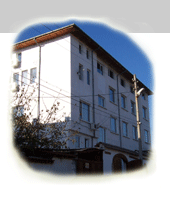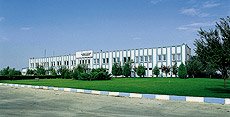Summer in New York heralds a new season for the apparel textile industry. This summer, seven shows opened their doors to industry visitors. As the number of textile trade shows grows, the focus of each show tightens.
Première Vision Preview — produced by Première Vision S.A., organizer of Première Vision — continues to reign supreme for top quality, innovation and creativity. This summer, 131 exhibitors from 13 countries participated, including some from South America, Eastern Europe and Asia. “The interest of the American buyer is in novelty,” said Philippe Pasquet, CEO, Première Vision. “Designers are looking for newness and fabrics that have a distinct look and performance.”
Texworld USA, produced by Messe Frankfurt Inc. in partnership with Lenzing Fibers Inc., moved to larger quarters at the Jacob Javits Convention Center. Now in its third season, the show hosted 194 exhibitors from 16 countries, mostly in Asia. Lenzing sponsored the Lenzing Innovation event at the show featuring Tencel® and Modal® fibers.
The Turkish Fashion Fabric Exhibition (TFFE), organized by the Istanbul Textile and Apparel Exporters’ Association, also changed its location. Now held in the Puck Building, the most recent edition featured 21 exhibitors showing classic suitings; clean shirtings; and knitted, denim and printed fabrics.
Prefab, the Supima Premium Fabric Show, now in its second season, is organized by Supima. The 14 exhibitors included spinners, weavers and knitters of quality fabrics.
Chinatown was the site of The Kingpins, a supply chain show sponsored by Dow Fiber Solutions’ Dow XLA™ fiber and Olah Inc. — a representative for major textile companies and garment factories in China, Japan, Indonesia, Portugal, Italy and Thailand. The focus of this show was denim and casualwear fabrics.
Direction and PrintSource focus on surface design. Studios from around the world sell original print designs, application treatments, patterns for woven and knitted fabrics, and antique swatches at these events.
For Fall/Winter 2008-09, the trend is to sophistication and refinement, with flatter surfaces, neat patterns and shine. The look may be subtle, but it is achieved through the use of intricate yarns and constructions. There is increased interest in organic; eco-friendly was a buzzword at all of the shows.
Suiting Fabrics
The trend at Première Vision Preview was to elegance. At Germany-based Becker & Fuhren Tuche GmbH & Co. KG, ultralight plain weaves are outselling twills. Super 160-micron compact wool yarns are going into soft, silky-smooth fabrics with a hairless surface and natural stretch. A 360-grams-per-square-meter (g/m2) herringbone woven with a slick wool face and brushed cotton/Lycra® back was popular at the show.
BTD Textile, Turkey, reported that 305-g/m2 flannels, pinstripes, twills and plain weaves in polyester/viscose/spandex and polyester/wool/viscose blends are in demand. “The flannel touch is important,” said Francesca De Vito, US agent for the company.
Shiny/dull double-faced fabrics shown by Italy-based Picchi S.p.A. are woven with a nylon face and wool back. Thick woven wools look as if they were knitted. For coats, textured wool is lacquer-finished or quilted with a puckered surface. One of the favorites is a classic plaid in a linen/wool blend. The hand is crisp and dry.
De Vaudricourt, France, showed novelty gray flannel. One version is woven using carded wool, viscose and nylon. The fabric is then chemically treated to dissolve the viscose, leaving a black spider-web pattern. Another flannel — a jacquard polyester/acrylic — has a cellophane-like linear abstract pattern.At Texworld, Toyoshima Co. Ltd., Japan, displayed total-easy-care basic suitweight fabrics made from wool and Tencel blends. Fabrics are finished to have a soft hand and sheen. China-based Mozartex Co. Ltd. showed soft, supple suitweight fabrics in wool blended with Tencel, cotton or polyester. Many fabrics are machine-washable. For casualwear, the company offers all-over pigment-printed fabrics that have been washed and sanded for an aged look and ultrasoft hand. Cotton/wool/spandex plain weaves, twills, moleskins and canvas at the Zhonghe Group, China, have a silky touch. Some are micro-sanded; others have an aero finish.
At TFFE, bamboo blended with silk or wool was of interest at Ipekis Mensucat T.A.S. The company showed lustrous gabardines, herringbones and mini-checks. Aksu exhibited lightweight, fluid fabrics with a soft touch in wool/Lycra and wool/silk blends. Mini-patterned weave effects were pointed out.
Casual
Denim is constantly changing, like a chameleon. Kara Nicholas, vice president, new product marketing at Greensboro, N.C.-based Cone Denim, a Prefab exhibitor, said the market is saturated with dark denim. Nicholas feels that colors and lighter shades are coming in; licorice gray is one color she mentioned. Cone Denim’s Black Seed Supima® cotton collection was of special interest at Prefab. Nicholas also mentioned increased interest in organic denim.
At TFFE, Kipas showed an eco-denim line. Marassi Denim highlighted gray and brown shades. Brights are selling in California, where organic cotton is also a factor; it is going to stores such as Zara and H&M.
Denim was the prime focus at The Kingpins. Japan-based Kurabo Industries Ltd. noted an interest in bleached and lighter-colored denims. Blends of Supima/XLA were pointed out. “The hand is softer, and there is better abrasion resistance than with other stretch fibers,” said Andrew Olah, CEO, Olah Inc., New York City, who sells Kurabo in America. Olah also showed denim at Prefab.
Germany-based DyStar Textilfarben GmbH & Co. Deutschland KG was a popular exhibitor at The Kingpins for designers and retailers who are looking for special garment processing. With the flexibility to handle small production and the ability to produce a wide range of effects, the company showed new applications and techniques for denim.
The Radici Group, Italy, focused on glamour in outerwear and casualwear at The Kingpins. Iridescent, yarn-dyed taffetas woven with metallic yarns; ultralight, soft, transparent, color-coated nylons; and double-faced sueded canvas are some of the early favorites.
At Première Vision Preview, Spain-based Royo Tejidos S.L. concurred that lighter colors, grays, browns and reds are incoming denim trends. It showed vintage looks and coated denim with a leathery quality. Olmetex S.p.A., Italy, showed shiny Teflon®-coated leather-look outerwear fabrics woven with metal and microfibers. England-based British Millerain Co. Ltd. showed heavy cotton canvas coated on both sides and used for motorcycle jackets. Frantissor Creations, France, is into shine with iridescent nylon that is gold-polyurethane-coated.
Yarns And Knits
Taiwan-based Kou Long Textile Co. Ltd., a Texworld exhibitor, is using bamboo, soy, corn and Tencel because they are eco-friendly. Lightweight, smooth, flat yarns are selling. Bros Holding Ltd., Hong Kong, showed organic cotton blended with cashmere, wool, bamboo and soy. Top-dyed mélange yarns were pointed out.
One of the newest developments at Buhler Quality Yarns Corp., Jefferson, Ga., a Prefab exhibitor, is Supima with Outlast®. David Sasso, vice president, international sales, said there is increased interest in performance in the knitwear industry.
At Prefab, Canada-based Tricots Liesse sold cellulosics for fall. Rayon, MicroModal® and Tencel were shown blended with cashmere, mohair, wool, silk and cotton. At Hong Kong-based Fountain Set Ltd., also a Prefab exhibitor, single-jersey, piqué and 1x1 rib knits featuring organic cotton and blends with wool, linen, bamboo, Tencel and recycled polyester are in demand. Organic and eco-friendly are certified through every step of the growing and production processes.
At Première Vision Preview, Spain-based Texdam S.L. showed wool-faced, nylon-backed geometric-patterned jacquards. Viscose/Lurex® stripes are light and soft. Bel Maille, France, is blending Lurex with wool, mohair and viscose. The company featured sweater knits splattered with glitter, tonal checks with specks of Lurex and sparkling, thick wool knits.
Moreno Valley, Calif-based Print House Studio Inc. presented its latest textile designs to visitors at PrintSource.
Prints
Early fall collections at the fabric shows indicate a continuation of large, swirling abstracts in tonal colors. Première Vision Preview exhibitor Miroglio S.p.A., Italy, said jersey and polyester stretch charmeuse are its best-selling base cloths. Confetti Fabrics, Turkey, mentioned rayon and spandex knits, green shades, and gray and yellow combinations. TFFE exhibitor Ipeker Tekstil showed dots, circles and swirls in pattern arrangements, spider-web designs on mottled grounds and metallic celestial shapes on dark grounds.
Fall collections at Direction and PrintSource were extensive. New York City-based Tom Cody Design, a Direction exhibitor, has developed bold Marimekko-inspired graphics and small, linear designs. Deco graphics in cosmetic colors, raindrop geometrics and eco-friendly tree patterns in shades of green also were shown.
Brewster HB, Design Union, The Colorfield Design Studio and Nixe Design Ltd. — all based in England — also exhibited at Direction. At Brewster, there was interest in tonal leaf prints on shiny satin. Blurred geometrics on gray grounds, dot/dash metallics, scratchy florals, vintage Edwardian looks and linear deco motifs were other trends noted. Design Union showed oversized florals and paisleys, patchwork graphics and melting shapes. The Colorfield featured large-scale moving graphics, blurred- and hard-edged designs, and tree patterns. Nixe Design offered fabrics featuring starburst shapes and wavy stripes.
Rubia Pigmenta Naturalia, the Netherlands, attracted special interest at Direction. The company produces natural dyes, and in January its new factory went online producing red shades. Yellow and blue will follow. For light shades, 6 kilograms (kg) will dye 100 kg of wool yarn. Italy-based linen weaver Crespi S.p.A. is a customer.
At PrintSource, several studios focused on juvenile prints including Bread & Butter Design and Fresh Squeezed Designs, both based in New York City. Bread and Butter showed Halloween black cats and pumpkins on orange tartan grounds, while Fresh Squeezed Designs had brightly colored apples. Story Design Studio, Healdsburg, Calif., showed abstract retro designs and sailboats. New York City-based Design Works International and Paris-based Fortier Price, also PrintSource exhibitors, showed monotone abstract designs, dotty patterns and neat linears. Many fabrics were shown in gray combinations and neutral shades.
New Show Announced
Massimo Iacoboni, producer of PrintSource, announced that Koncept, a new show he will produce for interior, surface and textile design, will take place at The Level at Metropolitan Pavilion in New York City, October 23-25. The show will focus on fabrics for upholstery, window treatments, carpets, table top, bed and bath, kitchen, home accents and accessories.




